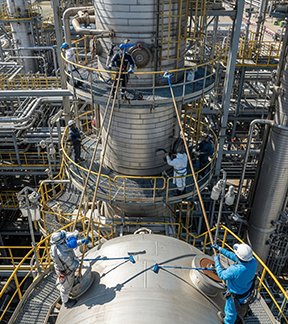Published: September 18, 2023 | Updated: October 09, 2025
Published: September 18, 2023 | Updated: October 09, 2025
Strengthening Ethanol Production Through Preventive Maintenance and Digital Systems
 Preventive maintenance practices in ethanol production facilities are more than just a set of procedures—they are a direct contributor to performance, safety, and sustainability. The sheer scale and sensitivity of an ethanol plant make proactive care non-negotiable. The integration of a Computerized Maintenance Management System (CMMS) brings clarity to complex tasks. In these plants, uptime depends on structured decisions and the right tools. Let's look at strengthening ethanol production through preventive maintenance and digital systems.
Preventive maintenance practices in ethanol production facilities are more than just a set of procedures—they are a direct contributor to performance, safety, and sustainability. The sheer scale and sensitivity of an ethanol plant make proactive care non-negotiable. The integration of a Computerized Maintenance Management System (CMMS) brings clarity to complex tasks. In these plants, uptime depends on structured decisions and the right tools. Let's look at strengthening ethanol production through preventive maintenance and digital systems.
Maintaining the Lifeblood of Production: Core Processing Equipment
Processing units carry the daily load in ethanol facilities. Pumps, agitators, centrifuges, and separators must run without obstruction. Deposits of starch or biological matter can reduce efficiency or cause damage over time. Cleaning protocols using pressure washers, industrial-grade solvents, and brushes remove buildup and prevent early wear. Every cycle of lubrication, filter replacement, and operational checks contributes to reliable throughput.
A CMMS assigns these recurring tasks with precision. It logs cleaning dates, records tool usage, and tracks completion time. This minimizes memory-based planning and introduces accountability. If one unit begins to underperform, historical data inside the CMMS points to trends in lubrication frequency or missed intervals. Predictability begins with visibility.
Component Upkeep: Valves, Pumps, Pipes, and Tanks
Interconnected parts—valves, pumps, transfer lines, and tanks—carry fluids and pressure throughout the facility. Small issues like seal degradation, loose flanges, or flow blockages often start subtly. Left unchecked, they evolve into major service interruptions. Crews must inspect connection points with calibrated tools: pressure gauges, torque wrenches, and thermal scanners.
Instead of relying on spreadsheets or paper logs, teams benefit from CMMS-tracked inspection frequencies. Checklists can be tailored per component. Alerts notify supervisors before a maintenance window closes. Downtime events due to leaking gaskets or faulty check valves become rarer with this digital oversight.
Cooling Systems and Process Stability
Temperature consistency ensures ethanol purity and safety. Cooling towers, chillers, and heat exchangers prevent overheating or batch loss. Problems often arise from hard water deposits clogging intake lines or from pump degradation. Inspection involves water quality testing, examining hose connections, and replacing worn cooling pads.
With a CMMS, water treatment routines can be time-stamped, chemical dosages documented, and service history connected to asset profiles. When a pump fails, technicians can check the CMMS for its entire service lifecycle—helping diagnose whether the issue was part failure, maintenance delay, or environmental factor.
Calibration and Control: Instrumentation Reliability
Accurate readings from flow meters, temperature sensors, and pressure transducers are critical. These systems govern reactions, control safety limits, and regulate feedstock dosing. Even a slight drift from true values can compromise entire batches.
Calibration tools such as loop calibrators, simulators, and digital pressure indicators ensure instrumentation precision. CMMS software schedules these calibrations, flags overdue instruments, and stores all past adjustments in audit-ready formats. It transforms calibration from reactive correction to strategic practice.
Bearings, Motors, and the Mechanics of Movement
Rotating assets like fans, agitators, and conveyors bear constant friction. Bearings degrade under stress. Motors accumulate heat and dust. Maintenance practices include visual inspection, vibration monitoring, and grease application. Kits include infrared thermometers and ultrasound detectors to spot early symptoms.
Tracking wear rates in a CMMS allows teams to project lifespan and rotate inventory more wisely. Replacement cycles become less guesswork and more predictive. Knowing how often a motor needed unplanned repair in the past reveals how it will perform in future loads.
Distillation Column Cleanliness and Inspection
Tall and narrow, distillation columns perform the final separation. As ethanol concentration increases, even minor fouling from chemical deposits can cause quality control issues. Teams use visual scopes, specialty brushes, and access platforms to reach difficult areas.
The CMMS helps here by linking inspection procedures to safety plans, providing digital access to cleaning documentation, and tracking solvent usage. Alerts can even flag columns overdue for servicing based on temperature deviation trends.
Fermentation Health Starts With the Tank
Fermentation tanks house biological activity essential for ethanol creation. But the same biology that enables conversion also leaves behind residues and contaminants. Scrubbing internal surfaces, flushing connections, and testing residue levels support healthy yeast performance.
In a CMMS, sanitation tasks become part of recurring workflows. Notes about unusual foaming or color changes can be logged and analyzed. A pattern might suggest equipment contamination or fermentation drift—both fixable when spotted early.
Boilers and Steam: Pressure Under Watch
Steam systems contribute thermal energy for processing. Boiler leaks or pressure faults bring production to a halt. Crews inspect expansion joints, test relief valves, and log fuel consumption. These tasks require caution and precision.
CMMS platforms provide a control center for boiler logs, inspections, and compliance records. Pressure events or emergency stops get time-stamped and associated with relevant data, supporting root-cause analysis and compliance documentation. It's not just maintenance—it's institutional memory.
Discover how streamlined maintenance processes can elevate production. Learn more.
Electrical Systems and Facility Integrity
 From control rooms to power panels, the electrical backbone demands attention. Degraded wires, damaged conduit, and moisture intrusion all threaten safety. Preventive tasks include breaker testing, IR thermal scans, and light fixture replacement.
From control rooms to power panels, the electrical backbone demands attention. Degraded wires, damaged conduit, and moisture intrusion all threaten safety. Preventive tasks include breaker testing, IR thermal scans, and light fixture replacement.
A CMMS allows electricians to prioritize high-risk areas, tie inspection reports to floorplans, and attach part numbers to each breaker panel. This builds a digital twin of the facility's power layout, reducing guesswork during repairs and shutdown planning.
Maintenance for Environmental and Compliance Monitoring
In ethanol production, oversight extends beyond operations—it includes environmental monitoring and regulatory reporting. Emissions controls, wastewater treatment, and spill containment systems require routine checks. These aren't merely legal requirements; they uphold the plant's reputation and future licensing.
With a CMMS, facilities create automatic task assignments for environmental monitoring. Reports generate in real-time, with compliance windows and due dates tracked transparently. When an inspector asks for tank calibration logs or valve replacement documentation, it's already there.
The Role of Strategy Before Implementation
No software system fixes disorder by itself. Facilities must evaluate what maintenance gaps exist and why. Start with one system—a recurring failure point, an underreported risk area. Build workflows inside the CMMS that match real operations, not ideal ones.
Implementation succeeds when crews understand how each task fits into the bigger picture. Assignments need clarity. Categories must reflect the language technicians already use. Over time, even disconnected departments—purchasing, safety, compliance—see benefit from shared digital oversight.
The challenge of ethanol production doesn't lie in scale—it lies in coordination. Preventive maintenance, paired with digital discipline through a CMMS, creates more than order. It allows the facility to anticipate, respond, and evolve. No two maintenance programs look the same, but the results from preparation are always visible—in output, in uptime, and in safety.
FAQs
What is the role of CMMS in maintaining core ethanol processing equipment?
A CMMS assigns recurring tasks like lubrication and filter replacement with precision, logs cleaning dates, and uses historical data to identify trends that contribute to reliable equipment throughput.
How does a CMMS enhance the maintenance of interconnected components like valves and pipes?
Teams use a CMMS to track inspection frequencies and utilize tailored checklists, which reduces downtime caused by small, unchecked issues like seal degradation or flow blockages.
Why is temperature consistency crucial, and how does a CMMS support cooling systems?
Temperature consistency ensures ethanol purity and safety; the CMMS supports cooling systems by time-stamping water treatment routines and documenting chemical dosages to diagnose pump failure causes.
How does CMMS software ensure the reliability of facility instrumentation?
CMMS software strategically schedules instrument calibrations using tools like loop calibrators, flags overdue instruments, and stores all past adjustments in audit-ready formats.
How does the MAPCON CMMS help manage boiler and steam system compliance records?
The MAPCON CMMS serves as a control center for boiler logs, inspections, and compliance records, time-stamping pressure events to support root-cause analysis and documentation.
How does CMMS support a facility's environmental and regulatory monitoring?
The CMMS automatically creates task assignments for environmental checks, generates real-time reports, and tracks compliance windows for emissions control and wastewater treatment systems.
MAPCON | 800-922-4336
MAPCON CMMS software empowers you to plan and execute PM tasks flawlessly, thanks to its wealth of features and customizable options. Want to see it for yourself? Click the button below to get your FREE 30-day trial of MAPCON!
Try It FREE!